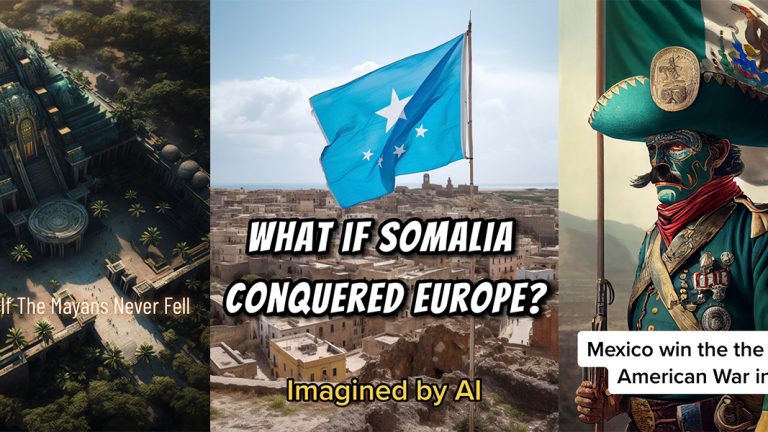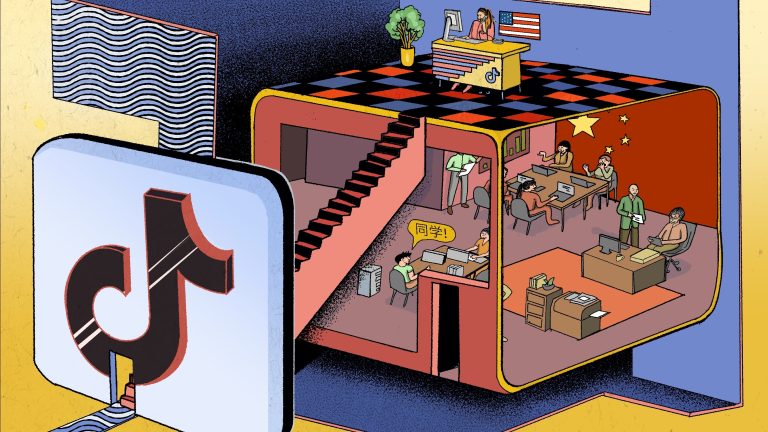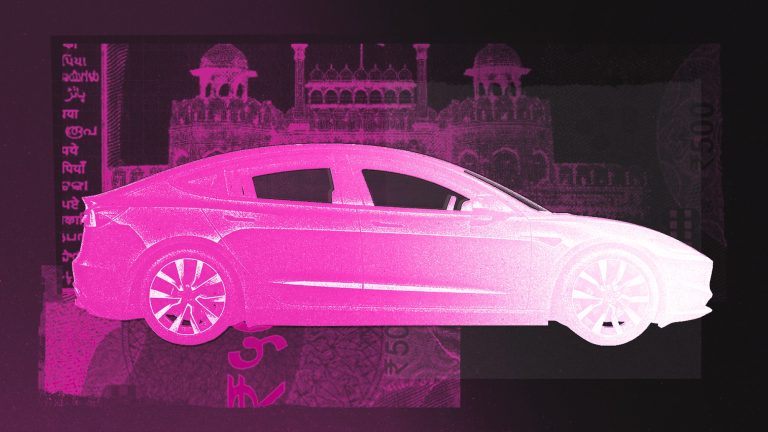“What if India ruled Great Britain?” reads the caption of a TikTok video, now viewed over 1.7 million times.
The prompt is followed by a series of faux documentary images that narrate a history which never happened: An industrial revolution set off the militarization of India. London fell to the Indian Armada, and wealthy Indian families settled in Great Britain. Queen Elizabeth, dressed in a sari, married into the Indian royal family. Each slide is accompanied by a photo created using generative artificial intelligence.
Since the launch of image generators like Stable Diffusion and Midjourney, a new wave of generative AI-focused creators have taken to TikTok. These accounts, some of which already have followings in the hundreds of thousands, post slideshow carousels of novel AI art. But one subset of creators is playing into a decolonial curiosity with its content — one that seems to ask, what if Western imperial nations never came to power?
The TikTok account @what.if_ai, for one, already has over 27,000 followers. It posts videos with prompts like, “What if Mexico invaded the U.S.?” and “What if Somalia conquered Europe?”
“None of this would be possible without AI image generation tools. That’s what’s so special about the emergence of AI. You can now conceive any thought and see it visualized in seconds.”
creator of What If? on TikTok



“They present these as neutral versions of what could have happened, but there’s a lot of assumptions. What does ChatGPT or Midjourney assume Islamic means? What do they assume India means?”
Nayana Prakash, PhD candidate at Oxford Internet Institute




“My viewers come from all around the world. Some live in ex-colonies like Somalia, India, and Ireland, and often they want to visualize a different history. One where perhaps they weren’t the colonized but rather the colonizer,” the creator behind @what.if_ai told Rest of World. A generative AI hobbyist, with a full-time job in the tech sector, the creator declined to share their name and location, over concerns their nationality will bias viewer reactions.
The comments section of @what.if_ai overflows with followers asking for their country’s turn in the AI time machine. “What would happen [if] Ethiopia colonized Italy?” asks one follower. “What if Paraguay [won] the war vs. Argentina Brazil and Uruguay,” writes another. “Plz do if Nigeria take[s] over the UK 🙏🏿.”
The creator behind @what.if_ai claims most of their ideas come from these commenters. After researching a given history, they use ChatGPT to generate scripts, and Midjourney to produce the accompanying visuals. Prior to these tools, the account may have required a team to produce videos, including researchers and script writers, as well as illustrators and video editors. “Now someone like me, with no artistic background, can create content that gets millions of views just from my own imagination,” they said. “Anyone can do it. I’m just early.”
“What would our ancestors look like? What would our cities look like? Let’s take a glimpse into this alternate reality.”
ChatGPT-generated narration



“By imagining a different history for the Philippines, I hope to contribute to this ongoing conversation about the legacy of colonialism and the possibilities for a more just future.”
Jerald Marin, creator of AI What If
Videos in the genre go viral regularly because they fill a gap in the imagination, according to Nayana Prakash, a PhD candidate at the Oxford Internet Institute, who researches storytelling platforms in India and marginalized voices on the internet. “We’re quite deprived of thinking about countries in the Global South as being the arbiters of power and, you know, futuristic,” Prakash told Rest of World.
She finds one subgenre particularly compelling — it reimagines the modern-day skyscraper age in the aesthetics of ancient societies. “What if the Mayan empire never fell,” reads one viral video prompt, followed by illustrations of cityscapes and monumental architecture with Mayan design influences.
“I think [these videos] give us an alternative view of what modernity means. If all of us had to define what it means to be modern or what modernity is, we would see that as a very American or Eurocentric word,” said Prakash.
Some creators are explicit in their push for Indigenous representation. Jerald Mira, a designer from Manila, started a TikTok channel of his own in February. One video called “What if the Philippines was never conquered by Spain?” has over 250,000 views. In this alternate history, sovereign Indigenous nations on the islands of the Philippines flourish for centuries. A longer-form version uploaded to YouTube, with a full narration generated by ChatGPT, has nearly as many views.
Followers often name their family’s Indigenous roots in the comments section. “I belong to T’boli tribe … and we are still preserving our culture and heritage … we never forget our roots,” reads one comment.
“As a Filipino myself, I have always been interested in our country’s rich and complex history, which includes centuries of colonization and oppression by foreign powers,” Mira told Rest of World, explaining that his videos ask viewers to think critically about the impact of colonization. “It is essential that we question and challenge the dominant narratives that have shaped our understanding of the past.”
Mira first experimented with Dall-E before landing on the image generator Midjourney. Multiple creators say the tool, available with a monthly subscription, creates the most lifelike images available for this type of content.
Revisionist history channels are not unprecedented on social media. On YouTube, 20-minute deep dives imagine the butterfly effect if the loser of a famous European battle or a world war had won. These YouTube creators mostly court history buffs, and lean heavily on slide decks, archival photos, and annotated maps. On TikTok, the audience is broader, pulling users into these alternate realities with fully realized visuals.
Despite upending the history of colonization as we know it, many of these TikTok videos are less radical than they may appear at first glance, according to Prakash. The majority of the videos, for instance, don’t actually imagine a future without colonial rule. Instead, they swap the roles of colonized and colonizer. Even accounts that post videos of ancient societies — like “What if ancient Egypt never fell?” — tend to depict their military power. They include images of armor and regalia that those Egyptian soldiers might wear today, visualizing them with automatic rifles in hand.
“I think we’re unable to imagine ourselves outside the histories that we’ve already lived through,” Prakash said. “It’s difficult to imagine, what does winning or success look like when it doesn’t involve invasion or colonialism? What does it mean for a country to have power if that power isn’t predicated on taking over another country? We’re just sort of reassigning parts in this existing play of history.”



